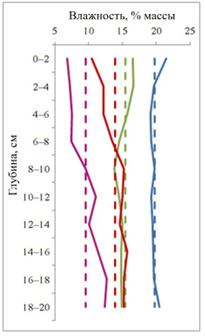Experimental study of thermogradient moisture migration in soil using a chemical marker
DOI:
https://doi.org/10.31251/pos.v8i2.315Keywords:
bulk soil columns; humidity profile; thermogradient movement; chloride ion; cryogenic accumulation.Abstract
The aim of the study was to examine experimentally the thermogradient migration of moisture in soil using a chemical marker.
Location and time of the study. The study was conducted in the laboratory during February-May 2025.
Methods. The study of the redistribution of moisture under the influence of a temperature gradient was carried out in columns of bulk soil of different granulometric composition. The method of chemical labeling was used to identify the predominant form of migrating moisture. The chloride ion was used as a marker. To form a moisture profile in the model soils, similar to the distribution of water in highly moistened natural soils, the pairs of columns with a preset moisture content were kept for 14 days at room temperature. Then, the profile moisture distribution was determined in one of the columns of each pair. The second column, moistened with an aqueous chloride ion solution, was placed in a refrigeration unit and cooled from above to subzero temperatures. At the same time, a positive temperature was maintained in the lower parts of the experimental columns. After 14 days, the vertical distribution of moisture in the second columns was determined by the thermostatic-weighing method and the chloride-ion-Mohr method. Samples were taken at 2 cm increments in two replicates. Conclusions about the forms of moisture movement under the influence of a temperature gradient were made based on the layered distribution of chloride ion.
Results. The moisture profile of previously highly moistened soils at room temperature was established: it can be considered an analogue of the vertical distribution of moisture in the soil and soil strata of the southern regions of Siberia during the warm season. In loamy and sandy loamy variants at depths of 4-12 cm, a decrease in humidity by 1% and its increase in the 0-4 cm layer by 1-2% was noted. This change was probably due to the intra-soil evaporation of moisture and its accumulation at the front of the insulating film on the column surfaces. The moisture profile acquired similarities with the profile of highly moistened steppe soils of heavy loamy, highly silty granulometric composition in steam-bearing areas with groundwater below the critical depth. In the sand variants, a decrease in the moisture content in the 0-10 cm layer by 1.0–2.5% and a corresponding increase in humidity in the lower part of the columns were found. It was likely that some of the moisture moved to the lower part of the profile under the influence of gravity. As a result, the columns of the sandy soil showed similarities in their moisture profile with the profiles of natural soils with closely located groundwater.
As a result of cooling from above, moisture moved to the frozen layer from the lower part in all profiles. The greatest extent of moisture movement was noted in the sandy soil: it revealed an increase in moisture content in the frozen part by 5-10% and a decrease in humidity in the thawed part by 2-4%. As the granulometric composition of soils becomes heavier, the volume of moisture that migrated into them decreased. In terms of external features, the moisture profiles obtained were similar to the segment of the moisture profile of natural soils in the lower part of the freezing zone and the upper part of the permafrost-drying zone when groundwater is below the critical depth.
The uniformity of the vertical distribution of chloride ion in all experimental columns after their cooling was revealed. The profile distribution of chloride was characterized by a sharp increase in its content in the frozen part and a relatively uniform distribution in the thawed part of the profile. On this basis, we believe that liquid water participated in cryogenic migration in all previously highly moistened soils. The establishment of a layer-by-layer correlation between the moisture content and the chloride ion showed that liquid water plays the greatest role in the frosty redistribution of moisture in heavy loamy, highly moistened soil. At the same time, cryogenic migration of moisture in medium loamy and sandy soils is carried out not only in liquid form.
Conclusions. As a result of the work carried out, the humidity parameters, at which cryogenic migration of moisture is carried out mainly in a liquid state, were elucidated in the studied soils.
Downloads

Downloads
Published
How to Cite
Issue
Section
License
Copyright (c) 2025 The Journal of Soils and Environment

This work is licensed under a Creative Commons Attribution 4.0 International License.






